COIT20253: Big Data and Value Creation in Healthcare Report
VerifiedAdded on 2022/12/21
|16
|3961
|2
Report
AI Summary
This report provides a comprehensive analysis of big data's applications within the healthcare industry. It begins by defining big data and its core characteristics, including volume, variety, and velocity, and then explores the significant opportunities it presents, such as reducing healthcare costs, fostering innovation, and enabling patient predictions through electronic health records. The report delves into how big data creates value by improving decision-making and organizational performance, detailing the four key capabilities needed to leverage this technology: data democratization, contextualization, experimentation, and execution. Furthermore, the report applies Porter's Value Chain Analysis to illustrate big data's impact on various healthcare activities, from inbound logistics to services and sales and marketing. It also utilizes Porter's Five Forces Analysis to examine the competitive landscape. The report concludes by emphasizing the transformative potential of big data in healthcare, highlighting the need for policy adjustments to balance advantages and patient data privacy.
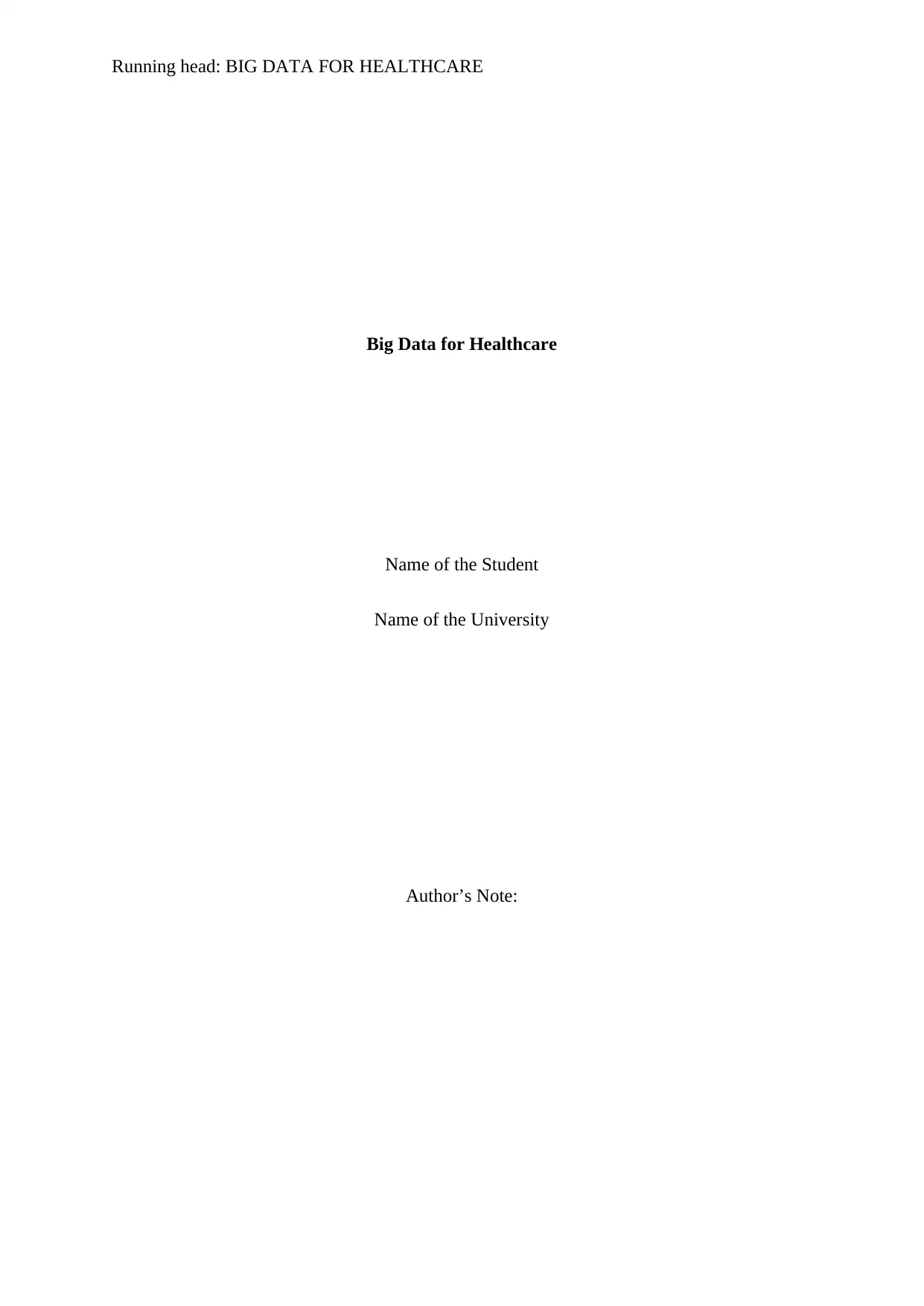
Running head: BIG DATA FOR HEALTHCARE
Big Data for Healthcare
Name of the Student
Name of the University
Author’s Note:
Big Data for Healthcare
Name of the Student
Name of the University
Author’s Note:
Paraphrase This Document
Need a fresh take? Get an instant paraphrase of this document with our AI Paraphraser
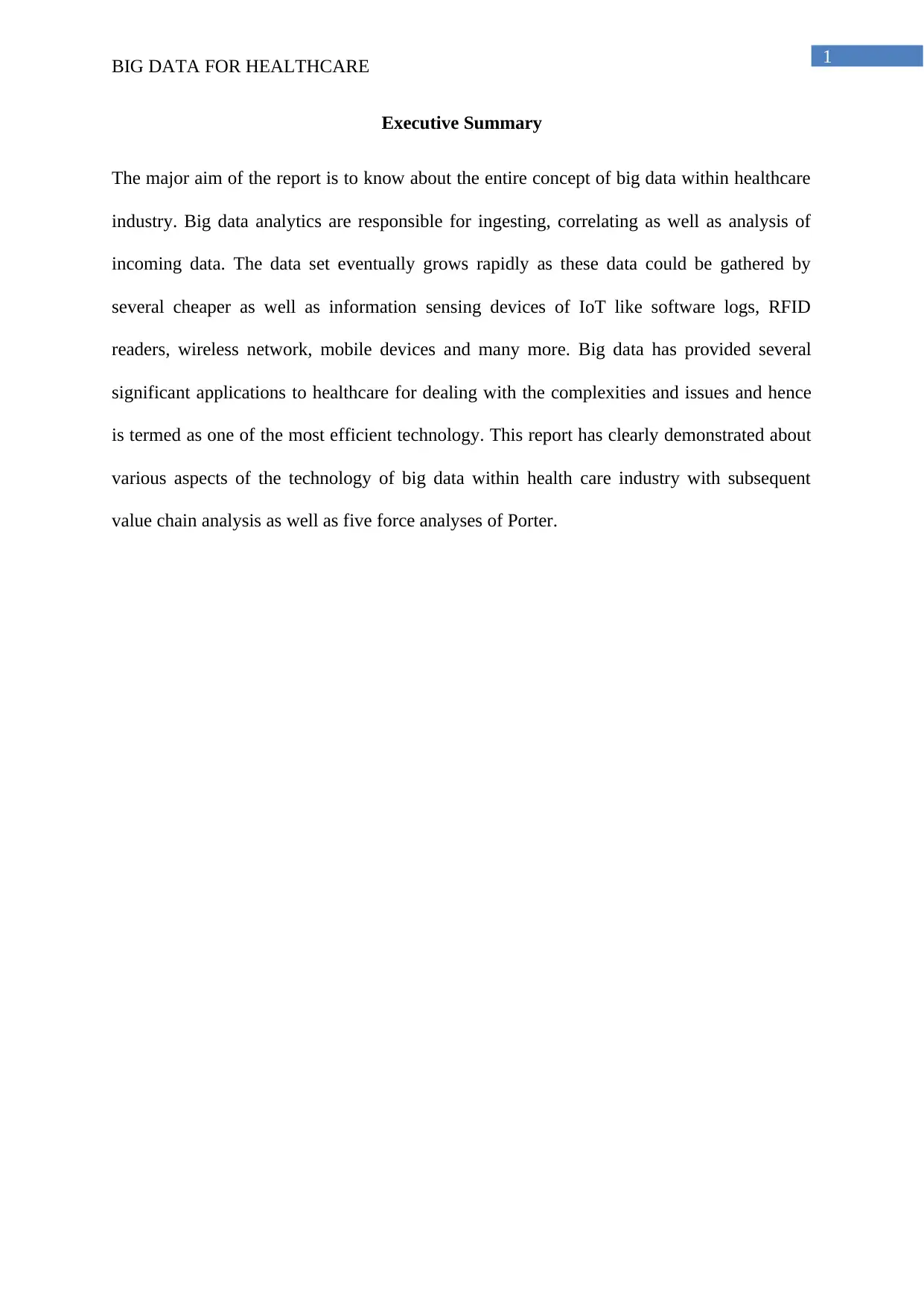
1
BIG DATA FOR HEALTHCARE
Executive Summary
The major aim of the report is to know about the entire concept of big data within healthcare
industry. Big data analytics are responsible for ingesting, correlating as well as analysis of
incoming data. The data set eventually grows rapidly as these data could be gathered by
several cheaper as well as information sensing devices of IoT like software logs, RFID
readers, wireless network, mobile devices and many more. Big data has provided several
significant applications to healthcare for dealing with the complexities and issues and hence
is termed as one of the most efficient technology. This report has clearly demonstrated about
various aspects of the technology of big data within health care industry with subsequent
value chain analysis as well as five force analyses of Porter.
BIG DATA FOR HEALTHCARE
Executive Summary
The major aim of the report is to know about the entire concept of big data within healthcare
industry. Big data analytics are responsible for ingesting, correlating as well as analysis of
incoming data. The data set eventually grows rapidly as these data could be gathered by
several cheaper as well as information sensing devices of IoT like software logs, RFID
readers, wireless network, mobile devices and many more. Big data has provided several
significant applications to healthcare for dealing with the complexities and issues and hence
is termed as one of the most efficient technology. This report has clearly demonstrated about
various aspects of the technology of big data within health care industry with subsequent
value chain analysis as well as five force analyses of Porter.
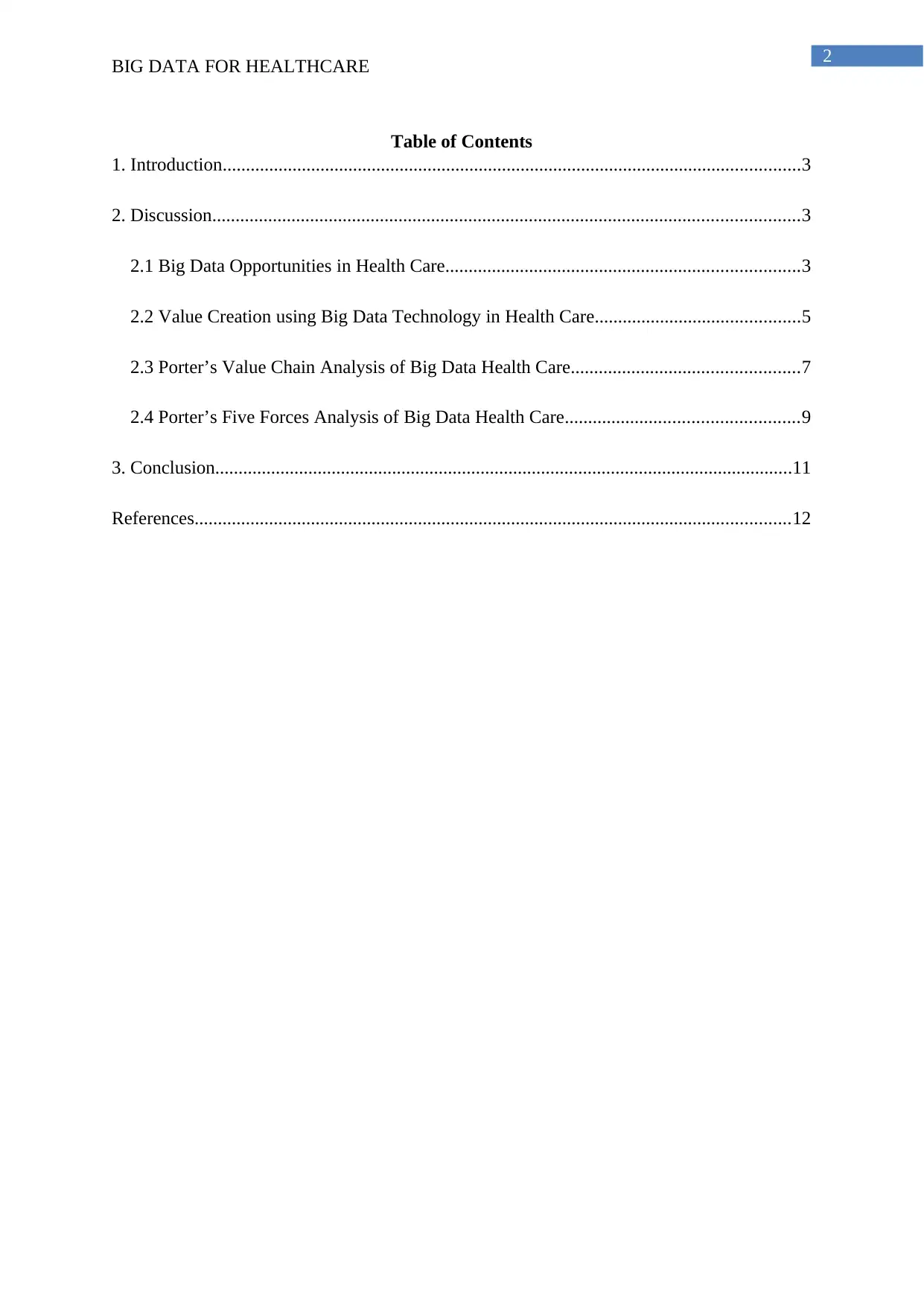
2
BIG DATA FOR HEALTHCARE
Table of Contents
1. Introduction............................................................................................................................3
2. Discussion..............................................................................................................................3
2.1 Big Data Opportunities in Health Care............................................................................3
2.2 Value Creation using Big Data Technology in Health Care............................................5
2.3 Porter’s Value Chain Analysis of Big Data Health Care.................................................7
2.4 Porter’s Five Forces Analysis of Big Data Health Care..................................................9
3. Conclusion............................................................................................................................11
References................................................................................................................................12
BIG DATA FOR HEALTHCARE
Table of Contents
1. Introduction............................................................................................................................3
2. Discussion..............................................................................................................................3
2.1 Big Data Opportunities in Health Care............................................................................3
2.2 Value Creation using Big Data Technology in Health Care............................................5
2.3 Porter’s Value Chain Analysis of Big Data Health Care.................................................7
2.4 Porter’s Five Forces Analysis of Big Data Health Care..................................................9
3. Conclusion............................................................................................................................11
References................................................................................................................................12
⊘ This is a preview!⊘
Do you want full access?
Subscribe today to unlock all pages.

Trusted by 1+ million students worldwide
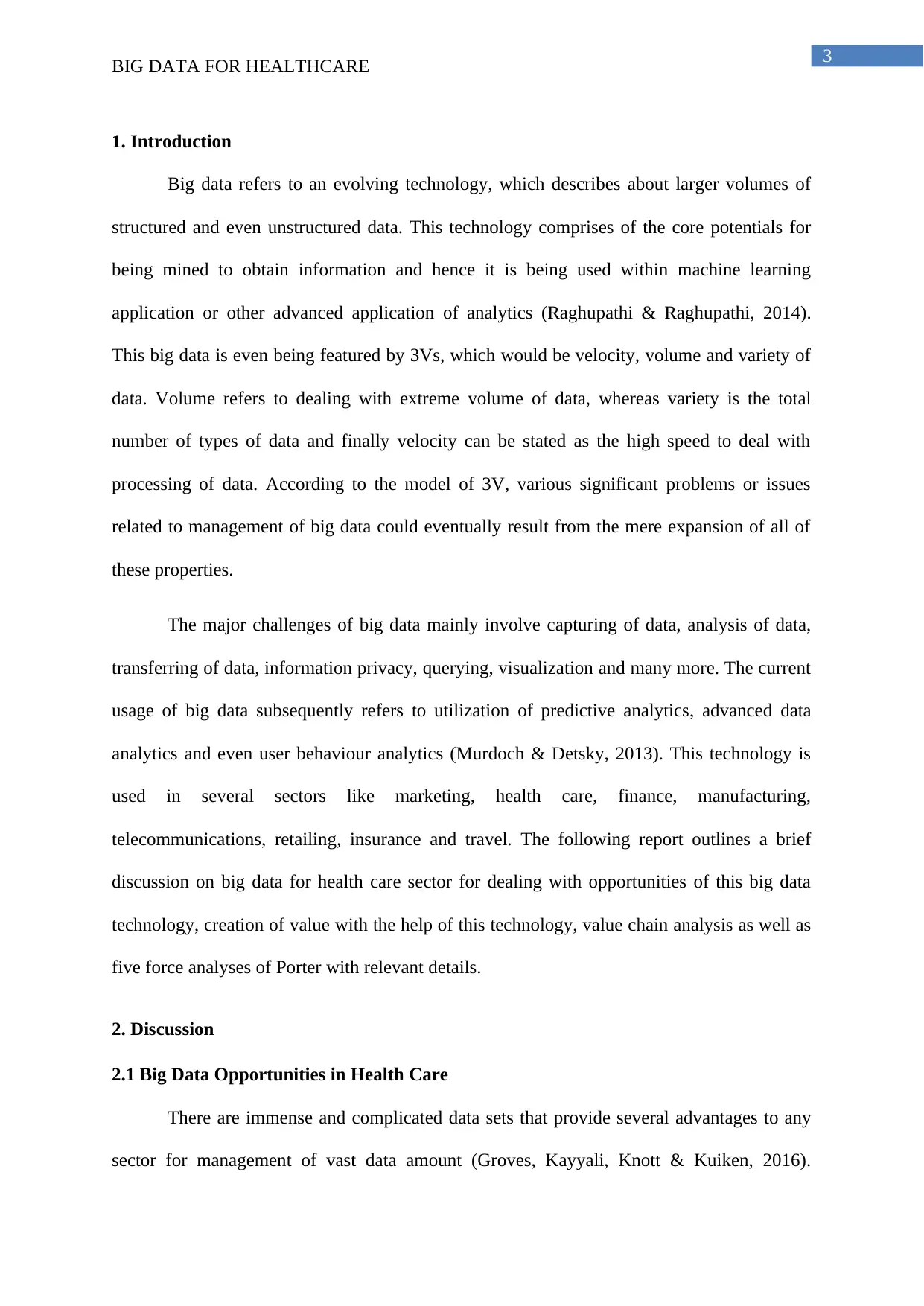
3
BIG DATA FOR HEALTHCARE
1. Introduction
Big data refers to an evolving technology, which describes about larger volumes of
structured and even unstructured data. This technology comprises of the core potentials for
being mined to obtain information and hence it is being used within machine learning
application or other advanced application of analytics (Raghupathi & Raghupathi, 2014).
This big data is even being featured by 3Vs, which would be velocity, volume and variety of
data. Volume refers to dealing with extreme volume of data, whereas variety is the total
number of types of data and finally velocity can be stated as the high speed to deal with
processing of data. According to the model of 3V, various significant problems or issues
related to management of big data could eventually result from the mere expansion of all of
these properties.
The major challenges of big data mainly involve capturing of data, analysis of data,
transferring of data, information privacy, querying, visualization and many more. The current
usage of big data subsequently refers to utilization of predictive analytics, advanced data
analytics and even user behaviour analytics (Murdoch & Detsky, 2013). This technology is
used in several sectors like marketing, health care, finance, manufacturing,
telecommunications, retailing, insurance and travel. The following report outlines a brief
discussion on big data for health care sector for dealing with opportunities of this big data
technology, creation of value with the help of this technology, value chain analysis as well as
five force analyses of Porter with relevant details.
2. Discussion
2.1 Big Data Opportunities in Health Care
There are immense and complicated data sets that provide several advantages to any
sector for management of vast data amount (Groves, Kayyali, Knott & Kuiken, 2016).
BIG DATA FOR HEALTHCARE
1. Introduction
Big data refers to an evolving technology, which describes about larger volumes of
structured and even unstructured data. This technology comprises of the core potentials for
being mined to obtain information and hence it is being used within machine learning
application or other advanced application of analytics (Raghupathi & Raghupathi, 2014).
This big data is even being featured by 3Vs, which would be velocity, volume and variety of
data. Volume refers to dealing with extreme volume of data, whereas variety is the total
number of types of data and finally velocity can be stated as the high speed to deal with
processing of data. According to the model of 3V, various significant problems or issues
related to management of big data could eventually result from the mere expansion of all of
these properties.
The major challenges of big data mainly involve capturing of data, analysis of data,
transferring of data, information privacy, querying, visualization and many more. The current
usage of big data subsequently refers to utilization of predictive analytics, advanced data
analytics and even user behaviour analytics (Murdoch & Detsky, 2013). This technology is
used in several sectors like marketing, health care, finance, manufacturing,
telecommunications, retailing, insurance and travel. The following report outlines a brief
discussion on big data for health care sector for dealing with opportunities of this big data
technology, creation of value with the help of this technology, value chain analysis as well as
five force analyses of Porter with relevant details.
2. Discussion
2.1 Big Data Opportunities in Health Care
There are immense and complicated data sets that provide several advantages to any
sector for management of vast data amount (Groves, Kayyali, Knott & Kuiken, 2016).
Paraphrase This Document
Need a fresh take? Get an instant paraphrase of this document with our AI Paraphraser
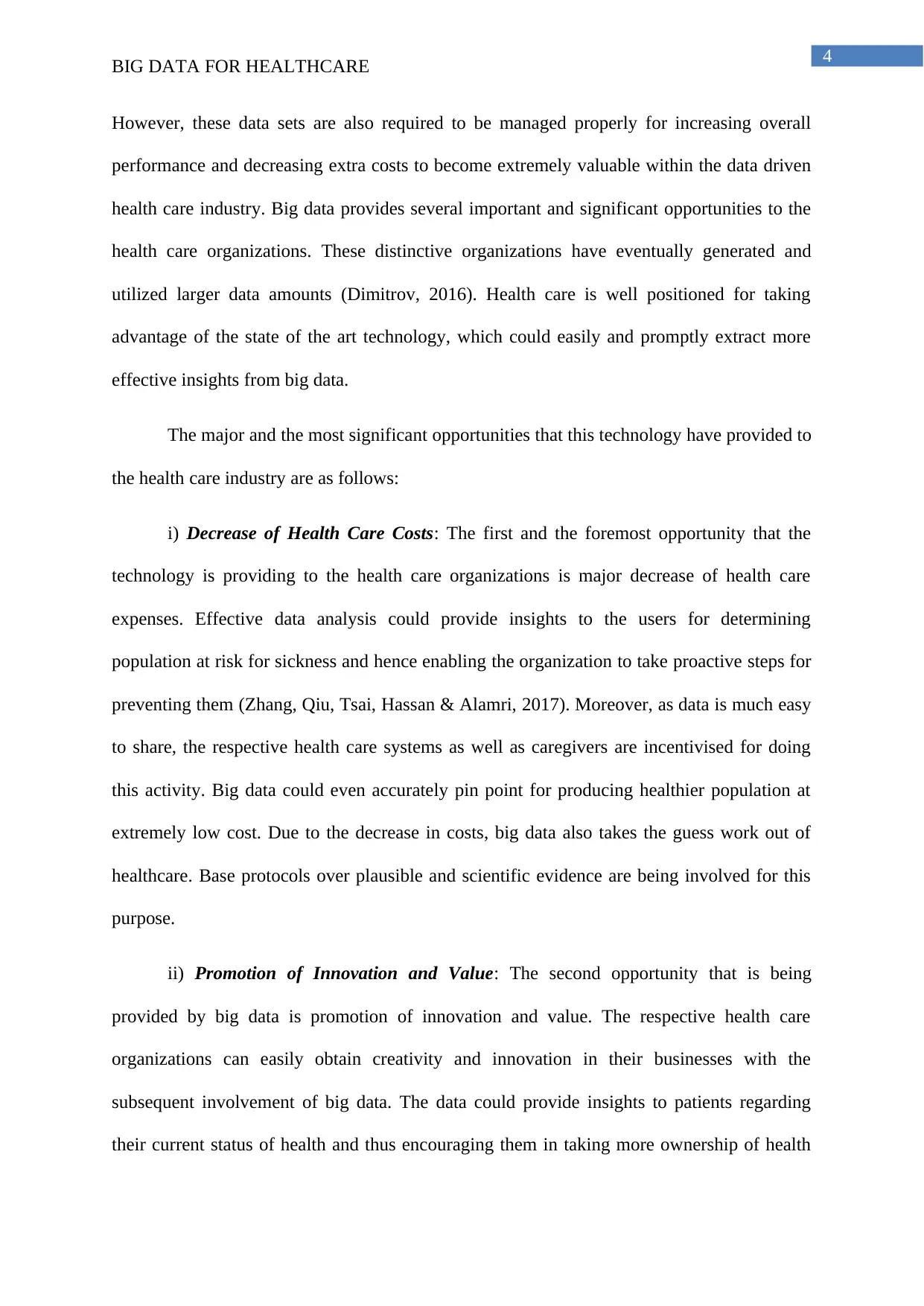
4
BIG DATA FOR HEALTHCARE
However, these data sets are also required to be managed properly for increasing overall
performance and decreasing extra costs to become extremely valuable within the data driven
health care industry. Big data provides several important and significant opportunities to the
health care organizations. These distinctive organizations have eventually generated and
utilized larger data amounts (Dimitrov, 2016). Health care is well positioned for taking
advantage of the state of the art technology, which could easily and promptly extract more
effective insights from big data.
The major and the most significant opportunities that this technology have provided to
the health care industry are as follows:
i) Decrease of Health Care Costs: The first and the foremost opportunity that the
technology is providing to the health care organizations is major decrease of health care
expenses. Effective data analysis could provide insights to the users for determining
population at risk for sickness and hence enabling the organization to take proactive steps for
preventing them (Zhang, Qiu, Tsai, Hassan & Alamri, 2017). Moreover, as data is much easy
to share, the respective health care systems as well as caregivers are incentivised for doing
this activity. Big data could even accurately pin point for producing healthier population at
extremely low cost. Due to the decrease in costs, big data also takes the guess work out of
healthcare. Base protocols over plausible and scientific evidence are being involved for this
purpose.
ii) Promotion of Innovation and Value: The second opportunity that is being
provided by big data is promotion of innovation and value. The respective health care
organizations can easily obtain creativity and innovation in their businesses with the
subsequent involvement of big data. The data could provide insights to patients regarding
their current status of health and thus encouraging them in taking more ownership of health
BIG DATA FOR HEALTHCARE
However, these data sets are also required to be managed properly for increasing overall
performance and decreasing extra costs to become extremely valuable within the data driven
health care industry. Big data provides several important and significant opportunities to the
health care organizations. These distinctive organizations have eventually generated and
utilized larger data amounts (Dimitrov, 2016). Health care is well positioned for taking
advantage of the state of the art technology, which could easily and promptly extract more
effective insights from big data.
The major and the most significant opportunities that this technology have provided to
the health care industry are as follows:
i) Decrease of Health Care Costs: The first and the foremost opportunity that the
technology is providing to the health care organizations is major decrease of health care
expenses. Effective data analysis could provide insights to the users for determining
population at risk for sickness and hence enabling the organization to take proactive steps for
preventing them (Zhang, Qiu, Tsai, Hassan & Alamri, 2017). Moreover, as data is much easy
to share, the respective health care systems as well as caregivers are incentivised for doing
this activity. Big data could even accurately pin point for producing healthier population at
extremely low cost. Due to the decrease in costs, big data also takes the guess work out of
healthcare. Base protocols over plausible and scientific evidence are being involved for this
purpose.
ii) Promotion of Innovation and Value: The second opportunity that is being
provided by big data is promotion of innovation and value. The respective health care
organizations can easily obtain creativity and innovation in their businesses with the
subsequent involvement of big data. The data could provide insights to patients regarding
their current status of health and thus encouraging them in taking more ownership of health
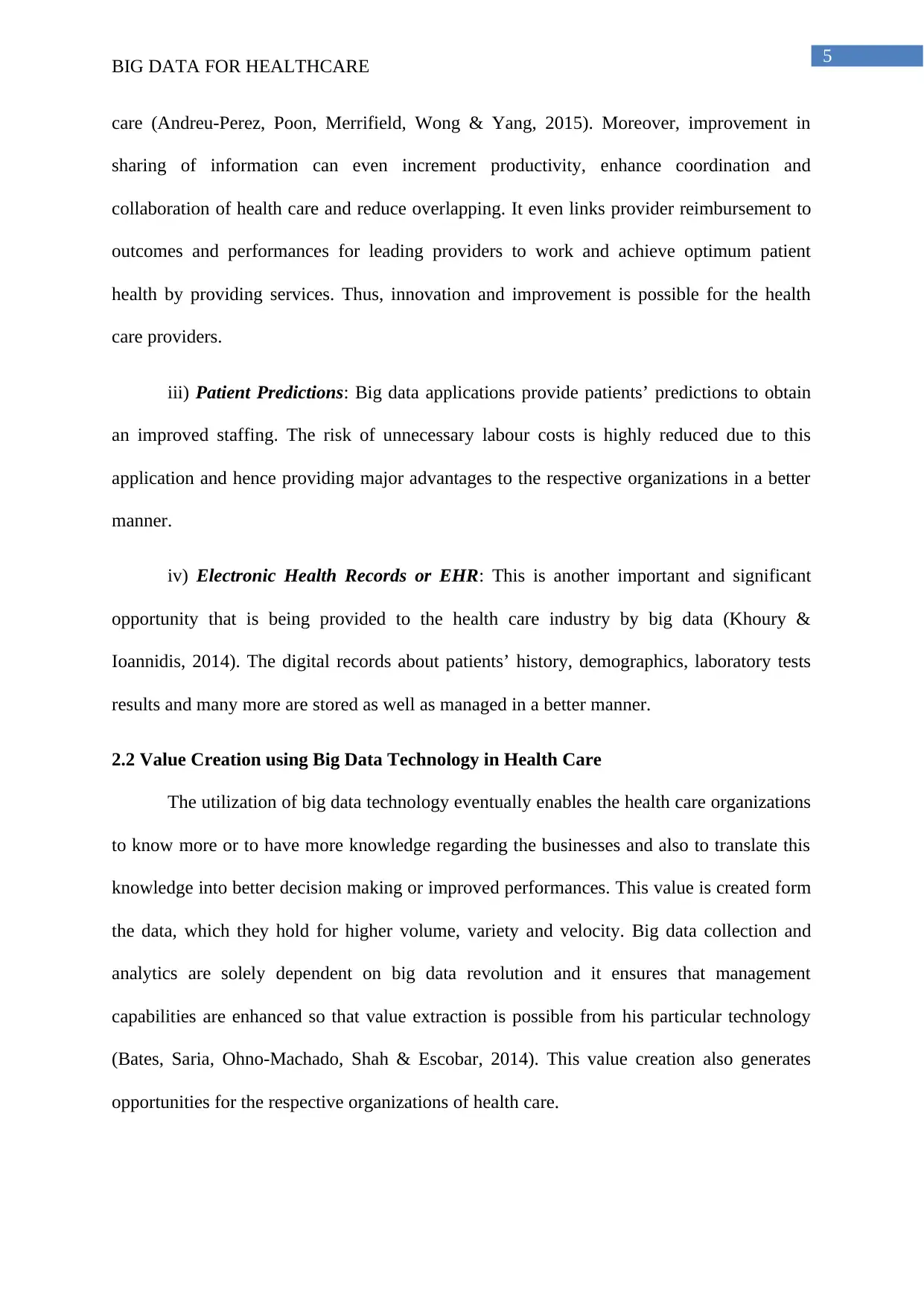
5
BIG DATA FOR HEALTHCARE
care (Andreu-Perez, Poon, Merrifield, Wong & Yang, 2015). Moreover, improvement in
sharing of information can even increment productivity, enhance coordination and
collaboration of health care and reduce overlapping. It even links provider reimbursement to
outcomes and performances for leading providers to work and achieve optimum patient
health by providing services. Thus, innovation and improvement is possible for the health
care providers.
iii) Patient Predictions: Big data applications provide patients’ predictions to obtain
an improved staffing. The risk of unnecessary labour costs is highly reduced due to this
application and hence providing major advantages to the respective organizations in a better
manner.
iv) Electronic Health Records or EHR: This is another important and significant
opportunity that is being provided to the health care industry by big data (Khoury &
Ioannidis, 2014). The digital records about patients’ history, demographics, laboratory tests
results and many more are stored as well as managed in a better manner.
2.2 Value Creation using Big Data Technology in Health Care
The utilization of big data technology eventually enables the health care organizations
to know more or to have more knowledge regarding the businesses and also to translate this
knowledge into better decision making or improved performances. This value is created form
the data, which they hold for higher volume, variety and velocity. Big data collection and
analytics are solely dependent on big data revolution and it ensures that management
capabilities are enhanced so that value extraction is possible from his particular technology
(Bates, Saria, Ohno-Machado, Shah & Escobar, 2014). This value creation also generates
opportunities for the respective organizations of health care.
BIG DATA FOR HEALTHCARE
care (Andreu-Perez, Poon, Merrifield, Wong & Yang, 2015). Moreover, improvement in
sharing of information can even increment productivity, enhance coordination and
collaboration of health care and reduce overlapping. It even links provider reimbursement to
outcomes and performances for leading providers to work and achieve optimum patient
health by providing services. Thus, innovation and improvement is possible for the health
care providers.
iii) Patient Predictions: Big data applications provide patients’ predictions to obtain
an improved staffing. The risk of unnecessary labour costs is highly reduced due to this
application and hence providing major advantages to the respective organizations in a better
manner.
iv) Electronic Health Records or EHR: This is another important and significant
opportunity that is being provided to the health care industry by big data (Khoury &
Ioannidis, 2014). The digital records about patients’ history, demographics, laboratory tests
results and many more are stored as well as managed in a better manner.
2.2 Value Creation using Big Data Technology in Health Care
The utilization of big data technology eventually enables the health care organizations
to know more or to have more knowledge regarding the businesses and also to translate this
knowledge into better decision making or improved performances. This value is created form
the data, which they hold for higher volume, variety and velocity. Big data collection and
analytics are solely dependent on big data revolution and it ensures that management
capabilities are enhanced so that value extraction is possible from his particular technology
(Bates, Saria, Ohno-Machado, Shah & Escobar, 2014). This value creation also generates
opportunities for the respective organizations of health care.
⊘ This is a preview!⊘
Do you want full access?
Subscribe today to unlock all pages.

Trusted by 1+ million students worldwide
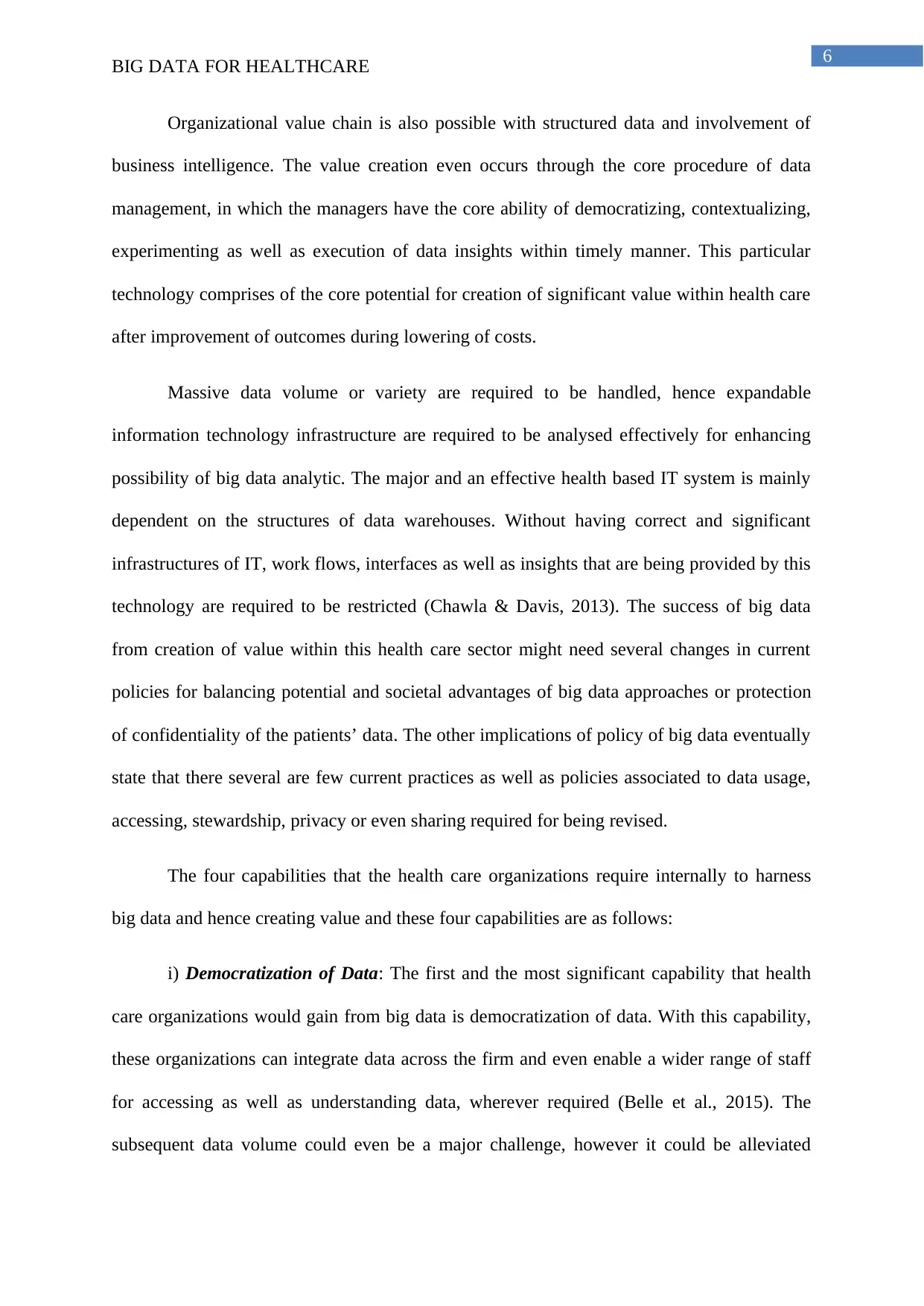
6
BIG DATA FOR HEALTHCARE
Organizational value chain is also possible with structured data and involvement of
business intelligence. The value creation even occurs through the core procedure of data
management, in which the managers have the core ability of democratizing, contextualizing,
experimenting as well as execution of data insights within timely manner. This particular
technology comprises of the core potential for creation of significant value within health care
after improvement of outcomes during lowering of costs.
Massive data volume or variety are required to be handled, hence expandable
information technology infrastructure are required to be analysed effectively for enhancing
possibility of big data analytic. The major and an effective health based IT system is mainly
dependent on the structures of data warehouses. Without having correct and significant
infrastructures of IT, work flows, interfaces as well as insights that are being provided by this
technology are required to be restricted (Chawla & Davis, 2013). The success of big data
from creation of value within this health care sector might need several changes in current
policies for balancing potential and societal advantages of big data approaches or protection
of confidentiality of the patients’ data. The other implications of policy of big data eventually
state that there several are few current practices as well as policies associated to data usage,
accessing, stewardship, privacy or even sharing required for being revised.
The four capabilities that the health care organizations require internally to harness
big data and hence creating value and these four capabilities are as follows:
i) Democratization of Data: The first and the most significant capability that health
care organizations would gain from big data is democratization of data. With this capability,
these organizations can integrate data across the firm and even enable a wider range of staff
for accessing as well as understanding data, wherever required (Belle et al., 2015). The
subsequent data volume could even be a major challenge, however it could be alleviated
BIG DATA FOR HEALTHCARE
Organizational value chain is also possible with structured data and involvement of
business intelligence. The value creation even occurs through the core procedure of data
management, in which the managers have the core ability of democratizing, contextualizing,
experimenting as well as execution of data insights within timely manner. This particular
technology comprises of the core potential for creation of significant value within health care
after improvement of outcomes during lowering of costs.
Massive data volume or variety are required to be handled, hence expandable
information technology infrastructure are required to be analysed effectively for enhancing
possibility of big data analytic. The major and an effective health based IT system is mainly
dependent on the structures of data warehouses. Without having correct and significant
infrastructures of IT, work flows, interfaces as well as insights that are being provided by this
technology are required to be restricted (Chawla & Davis, 2013). The success of big data
from creation of value within this health care sector might need several changes in current
policies for balancing potential and societal advantages of big data approaches or protection
of confidentiality of the patients’ data. The other implications of policy of big data eventually
state that there several are few current practices as well as policies associated to data usage,
accessing, stewardship, privacy or even sharing required for being revised.
The four capabilities that the health care organizations require internally to harness
big data and hence creating value and these four capabilities are as follows:
i) Democratization of Data: The first and the most significant capability that health
care organizations would gain from big data is democratization of data. With this capability,
these organizations can integrate data across the firm and even enable a wider range of staff
for accessing as well as understanding data, wherever required (Belle et al., 2015). The
subsequent data volume could even be a major challenge, however it could be alleviated
Paraphrase This Document
Need a fresh take? Get an instant paraphrase of this document with our AI Paraphraser
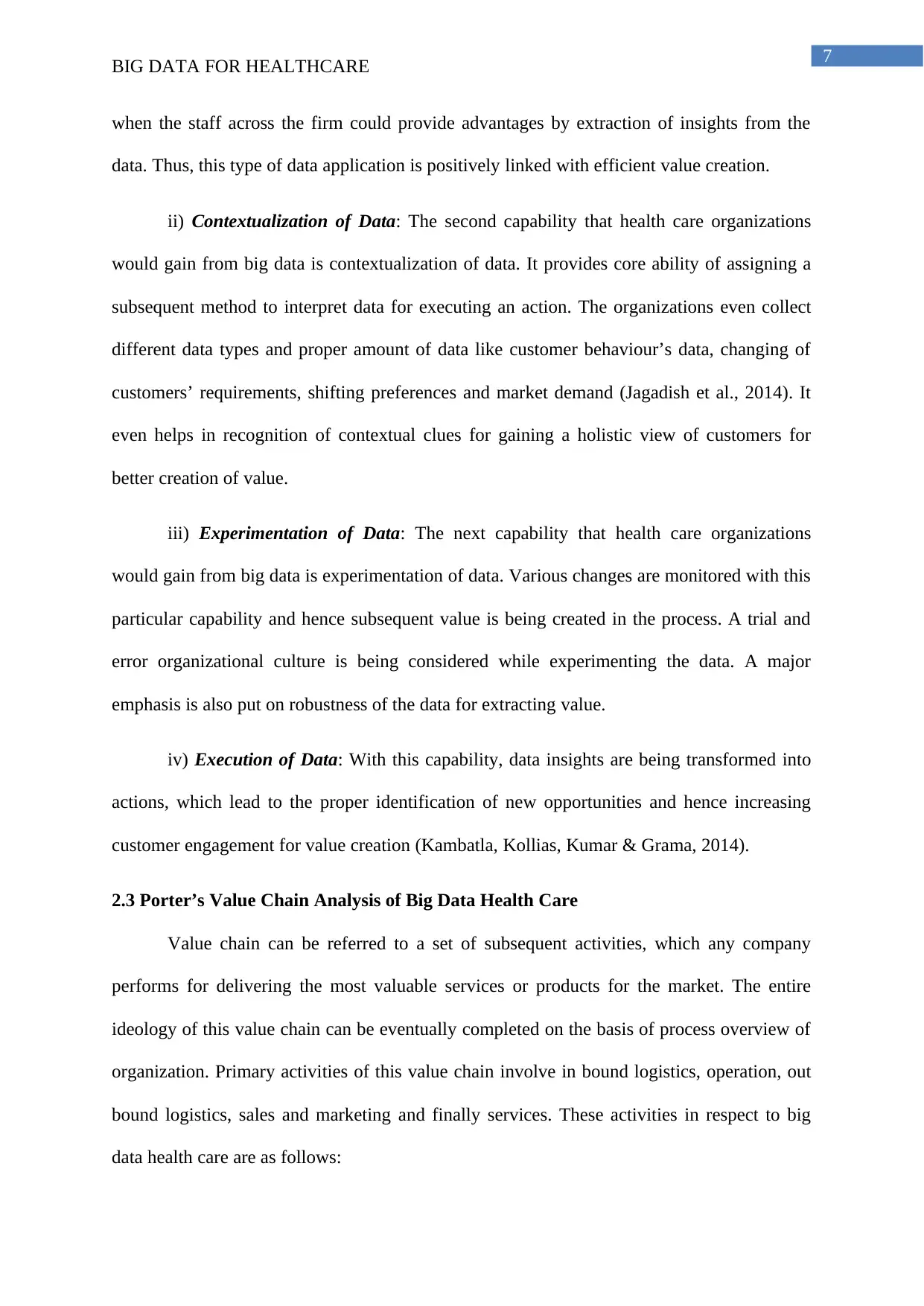
7
BIG DATA FOR HEALTHCARE
when the staff across the firm could provide advantages by extraction of insights from the
data. Thus, this type of data application is positively linked with efficient value creation.
ii) Contextualization of Data: The second capability that health care organizations
would gain from big data is contextualization of data. It provides core ability of assigning a
subsequent method to interpret data for executing an action. The organizations even collect
different data types and proper amount of data like customer behaviour’s data, changing of
customers’ requirements, shifting preferences and market demand (Jagadish et al., 2014). It
even helps in recognition of contextual clues for gaining a holistic view of customers for
better creation of value.
iii) Experimentation of Data: The next capability that health care organizations
would gain from big data is experimentation of data. Various changes are monitored with this
particular capability and hence subsequent value is being created in the process. A trial and
error organizational culture is being considered while experimenting the data. A major
emphasis is also put on robustness of the data for extracting value.
iv) Execution of Data: With this capability, data insights are being transformed into
actions, which lead to the proper identification of new opportunities and hence increasing
customer engagement for value creation (Kambatla, Kollias, Kumar & Grama, 2014).
2.3 Porter’s Value Chain Analysis of Big Data Health Care
Value chain can be referred to a set of subsequent activities, which any company
performs for delivering the most valuable services or products for the market. The entire
ideology of this value chain can be eventually completed on the basis of process overview of
organization. Primary activities of this value chain involve in bound logistics, operation, out
bound logistics, sales and marketing and finally services. These activities in respect to big
data health care are as follows:
BIG DATA FOR HEALTHCARE
when the staff across the firm could provide advantages by extraction of insights from the
data. Thus, this type of data application is positively linked with efficient value creation.
ii) Contextualization of Data: The second capability that health care organizations
would gain from big data is contextualization of data. It provides core ability of assigning a
subsequent method to interpret data for executing an action. The organizations even collect
different data types and proper amount of data like customer behaviour’s data, changing of
customers’ requirements, shifting preferences and market demand (Jagadish et al., 2014). It
even helps in recognition of contextual clues for gaining a holistic view of customers for
better creation of value.
iii) Experimentation of Data: The next capability that health care organizations
would gain from big data is experimentation of data. Various changes are monitored with this
particular capability and hence subsequent value is being created in the process. A trial and
error organizational culture is being considered while experimenting the data. A major
emphasis is also put on robustness of the data for extracting value.
iv) Execution of Data: With this capability, data insights are being transformed into
actions, which lead to the proper identification of new opportunities and hence increasing
customer engagement for value creation (Kambatla, Kollias, Kumar & Grama, 2014).
2.3 Porter’s Value Chain Analysis of Big Data Health Care
Value chain can be referred to a set of subsequent activities, which any company
performs for delivering the most valuable services or products for the market. The entire
ideology of this value chain can be eventually completed on the basis of process overview of
organization. Primary activities of this value chain involve in bound logistics, operation, out
bound logistics, sales and marketing and finally services. These activities in respect to big
data health care are as follows:
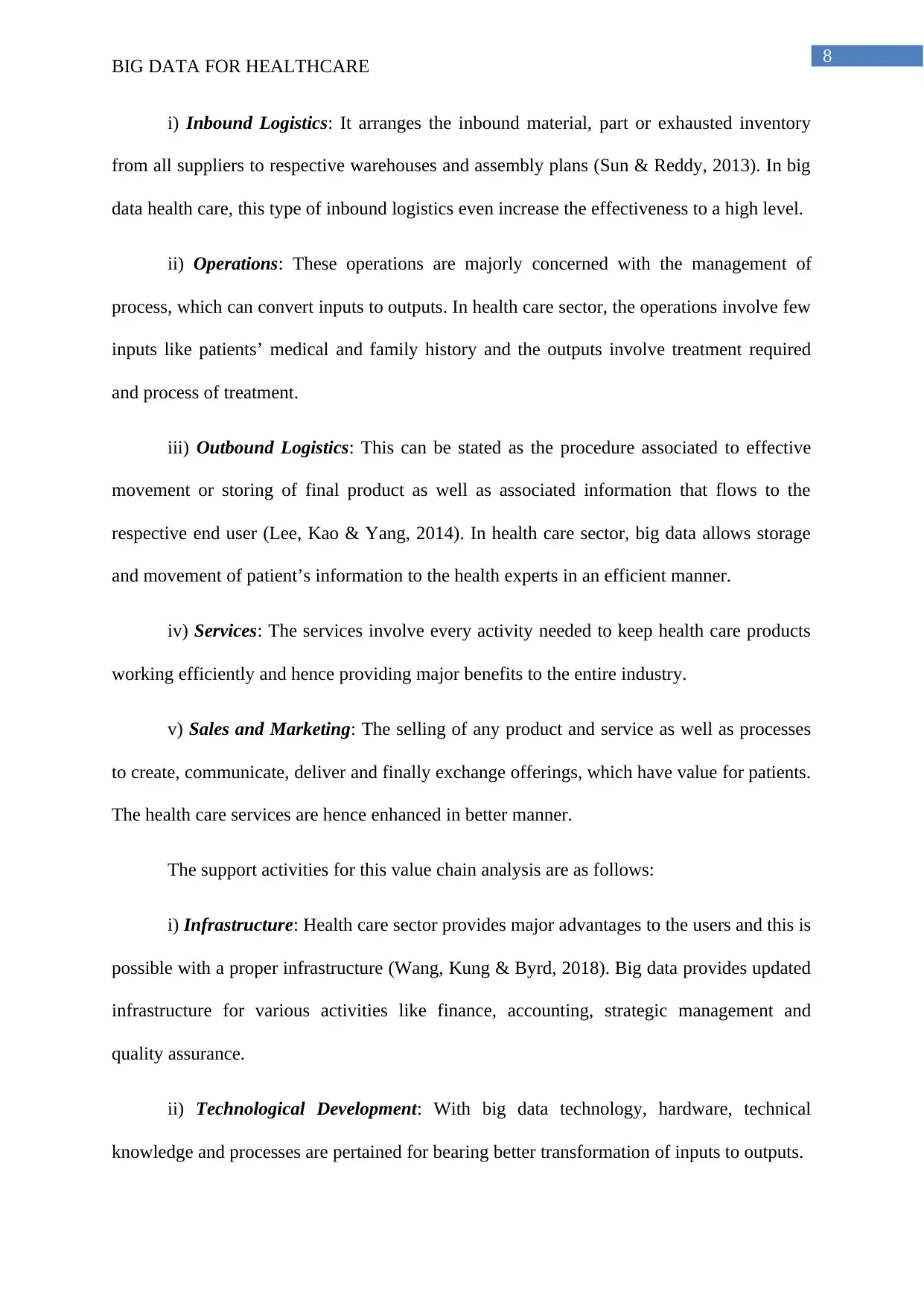
8
BIG DATA FOR HEALTHCARE
i) Inbound Logistics: It arranges the inbound material, part or exhausted inventory
from all suppliers to respective warehouses and assembly plans (Sun & Reddy, 2013). In big
data health care, this type of inbound logistics even increase the effectiveness to a high level.
ii) Operations: These operations are majorly concerned with the management of
process, which can convert inputs to outputs. In health care sector, the operations involve few
inputs like patients’ medical and family history and the outputs involve treatment required
and process of treatment.
iii) Outbound Logistics: This can be stated as the procedure associated to effective
movement or storing of final product as well as associated information that flows to the
respective end user (Lee, Kao & Yang, 2014). In health care sector, big data allows storage
and movement of patient’s information to the health experts in an efficient manner.
iv) Services: The services involve every activity needed to keep health care products
working efficiently and hence providing major benefits to the entire industry.
v) Sales and Marketing: The selling of any product and service as well as processes
to create, communicate, deliver and finally exchange offerings, which have value for patients.
The health care services are hence enhanced in better manner.
The support activities for this value chain analysis are as follows:
i) Infrastructure: Health care sector provides major advantages to the users and this is
possible with a proper infrastructure (Wang, Kung & Byrd, 2018). Big data provides updated
infrastructure for various activities like finance, accounting, strategic management and
quality assurance.
ii) Technological Development: With big data technology, hardware, technical
knowledge and processes are pertained for bearing better transformation of inputs to outputs.
BIG DATA FOR HEALTHCARE
i) Inbound Logistics: It arranges the inbound material, part or exhausted inventory
from all suppliers to respective warehouses and assembly plans (Sun & Reddy, 2013). In big
data health care, this type of inbound logistics even increase the effectiveness to a high level.
ii) Operations: These operations are majorly concerned with the management of
process, which can convert inputs to outputs. In health care sector, the operations involve few
inputs like patients’ medical and family history and the outputs involve treatment required
and process of treatment.
iii) Outbound Logistics: This can be stated as the procedure associated to effective
movement or storing of final product as well as associated information that flows to the
respective end user (Lee, Kao & Yang, 2014). In health care sector, big data allows storage
and movement of patient’s information to the health experts in an efficient manner.
iv) Services: The services involve every activity needed to keep health care products
working efficiently and hence providing major benefits to the entire industry.
v) Sales and Marketing: The selling of any product and service as well as processes
to create, communicate, deliver and finally exchange offerings, which have value for patients.
The health care services are hence enhanced in better manner.
The support activities for this value chain analysis are as follows:
i) Infrastructure: Health care sector provides major advantages to the users and this is
possible with a proper infrastructure (Wang, Kung & Byrd, 2018). Big data provides updated
infrastructure for various activities like finance, accounting, strategic management and
quality assurance.
ii) Technological Development: With big data technology, hardware, technical
knowledge and processes are pertained for bearing better transformation of inputs to outputs.
⊘ This is a preview!⊘
Do you want full access?
Subscribe today to unlock all pages.

Trusted by 1+ million students worldwide
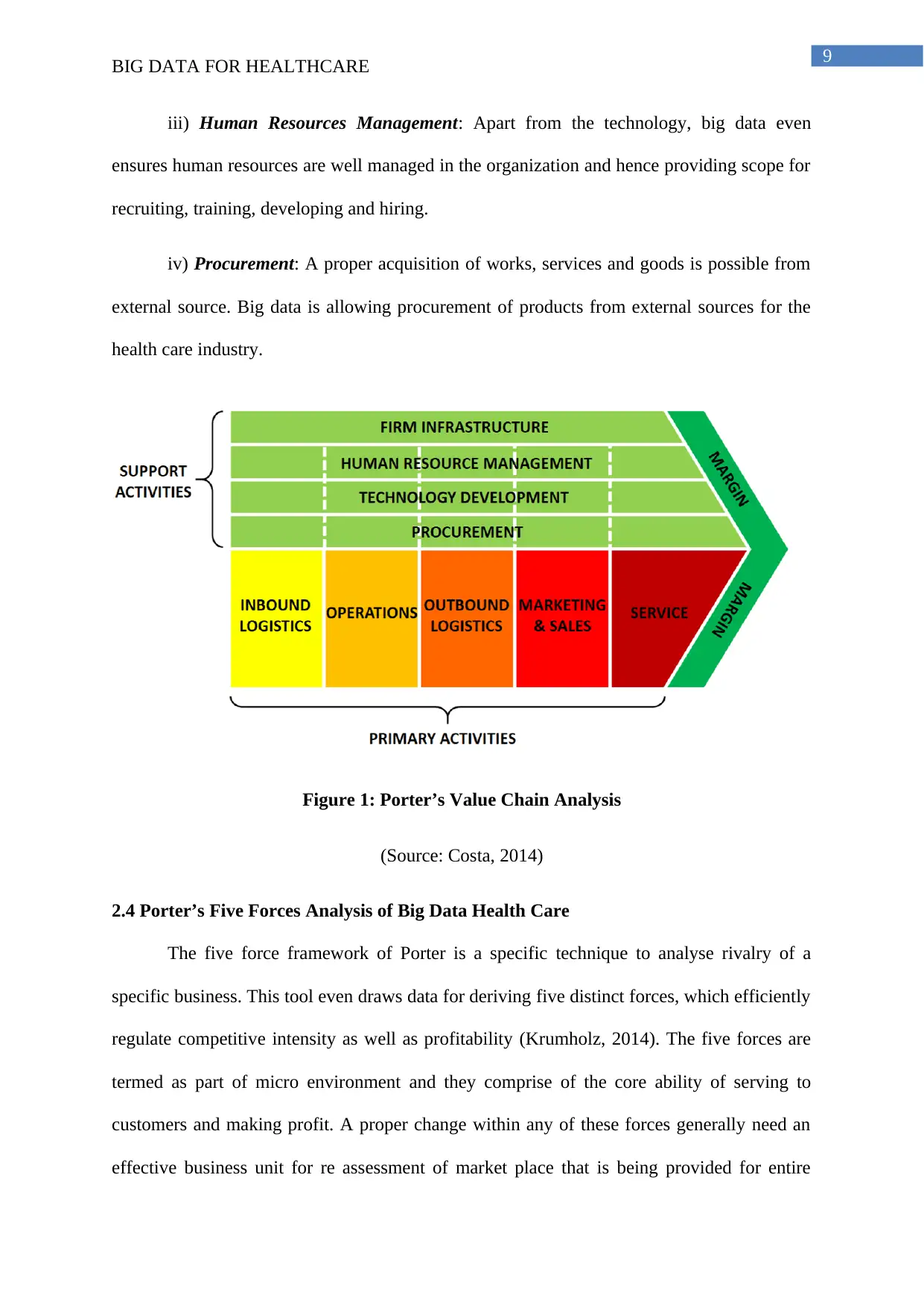
9
BIG DATA FOR HEALTHCARE
iii) Human Resources Management: Apart from the technology, big data even
ensures human resources are well managed in the organization and hence providing scope for
recruiting, training, developing and hiring.
iv) Procurement: A proper acquisition of works, services and goods is possible from
external source. Big data is allowing procurement of products from external sources for the
health care industry.
Figure 1: Porter’s Value Chain Analysis
(Source: Costa, 2014)
2.4 Porter’s Five Forces Analysis of Big Data Health Care
The five force framework of Porter is a specific technique to analyse rivalry of a
specific business. This tool even draws data for deriving five distinct forces, which efficiently
regulate competitive intensity as well as profitability (Krumholz, 2014). The five forces are
termed as part of micro environment and they comprise of the core ability of serving to
customers and making profit. A proper change within any of these forces generally need an
effective business unit for re assessment of market place that is being provided for entire
BIG DATA FOR HEALTHCARE
iii) Human Resources Management: Apart from the technology, big data even
ensures human resources are well managed in the organization and hence providing scope for
recruiting, training, developing and hiring.
iv) Procurement: A proper acquisition of works, services and goods is possible from
external source. Big data is allowing procurement of products from external sources for the
health care industry.
Figure 1: Porter’s Value Chain Analysis
(Source: Costa, 2014)
2.4 Porter’s Five Forces Analysis of Big Data Health Care
The five force framework of Porter is a specific technique to analyse rivalry of a
specific business. This tool even draws data for deriving five distinct forces, which efficiently
regulate competitive intensity as well as profitability (Krumholz, 2014). The five forces are
termed as part of micro environment and they comprise of the core ability of serving to
customers and making profit. A proper change within any of these forces generally need an
effective business unit for re assessment of market place that is being provided for entire
Paraphrase This Document
Need a fresh take? Get an instant paraphrase of this document with our AI Paraphraser
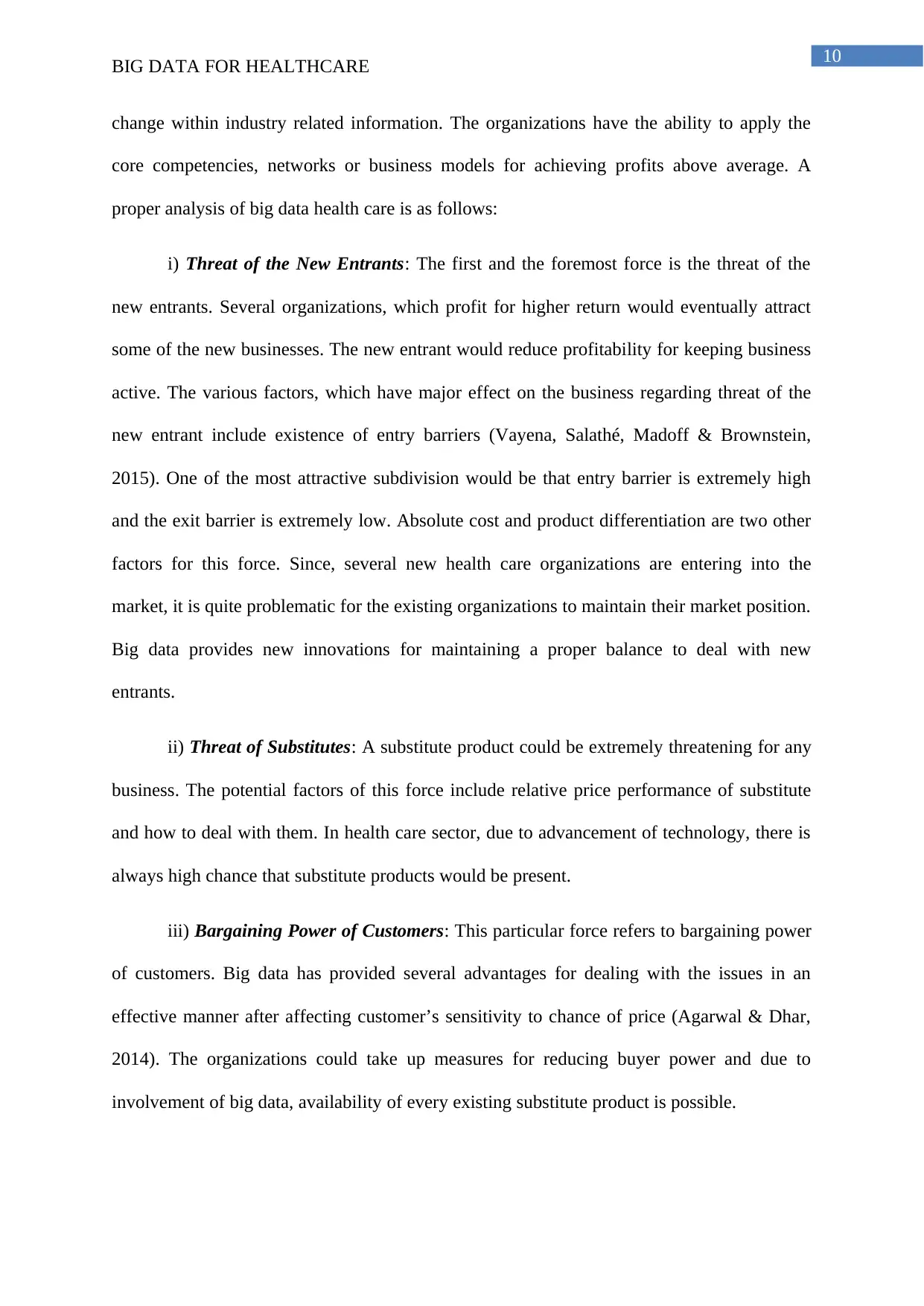
10
BIG DATA FOR HEALTHCARE
change within industry related information. The organizations have the ability to apply the
core competencies, networks or business models for achieving profits above average. A
proper analysis of big data health care is as follows:
i) Threat of the New Entrants: The first and the foremost force is the threat of the
new entrants. Several organizations, which profit for higher return would eventually attract
some of the new businesses. The new entrant would reduce profitability for keeping business
active. The various factors, which have major effect on the business regarding threat of the
new entrant include existence of entry barriers (Vayena, Salathé, Madoff & Brownstein,
2015). One of the most attractive subdivision would be that entry barrier is extremely high
and the exit barrier is extremely low. Absolute cost and product differentiation are two other
factors for this force. Since, several new health care organizations are entering into the
market, it is quite problematic for the existing organizations to maintain their market position.
Big data provides new innovations for maintaining a proper balance to deal with new
entrants.
ii) Threat of Substitutes: A substitute product could be extremely threatening for any
business. The potential factors of this force include relative price performance of substitute
and how to deal with them. In health care sector, due to advancement of technology, there is
always high chance that substitute products would be present.
iii) Bargaining Power of Customers: This particular force refers to bargaining power
of customers. Big data has provided several advantages for dealing with the issues in an
effective manner after affecting customer’s sensitivity to chance of price (Agarwal & Dhar,
2014). The organizations could take up measures for reducing buyer power and due to
involvement of big data, availability of every existing substitute product is possible.
BIG DATA FOR HEALTHCARE
change within industry related information. The organizations have the ability to apply the
core competencies, networks or business models for achieving profits above average. A
proper analysis of big data health care is as follows:
i) Threat of the New Entrants: The first and the foremost force is the threat of the
new entrants. Several organizations, which profit for higher return would eventually attract
some of the new businesses. The new entrant would reduce profitability for keeping business
active. The various factors, which have major effect on the business regarding threat of the
new entrant include existence of entry barriers (Vayena, Salathé, Madoff & Brownstein,
2015). One of the most attractive subdivision would be that entry barrier is extremely high
and the exit barrier is extremely low. Absolute cost and product differentiation are two other
factors for this force. Since, several new health care organizations are entering into the
market, it is quite problematic for the existing organizations to maintain their market position.
Big data provides new innovations for maintaining a proper balance to deal with new
entrants.
ii) Threat of Substitutes: A substitute product could be extremely threatening for any
business. The potential factors of this force include relative price performance of substitute
and how to deal with them. In health care sector, due to advancement of technology, there is
always high chance that substitute products would be present.
iii) Bargaining Power of Customers: This particular force refers to bargaining power
of customers. Big data has provided several advantages for dealing with the issues in an
effective manner after affecting customer’s sensitivity to chance of price (Agarwal & Dhar,
2014). The organizations could take up measures for reducing buyer power and due to
involvement of big data, availability of every existing substitute product is possible.
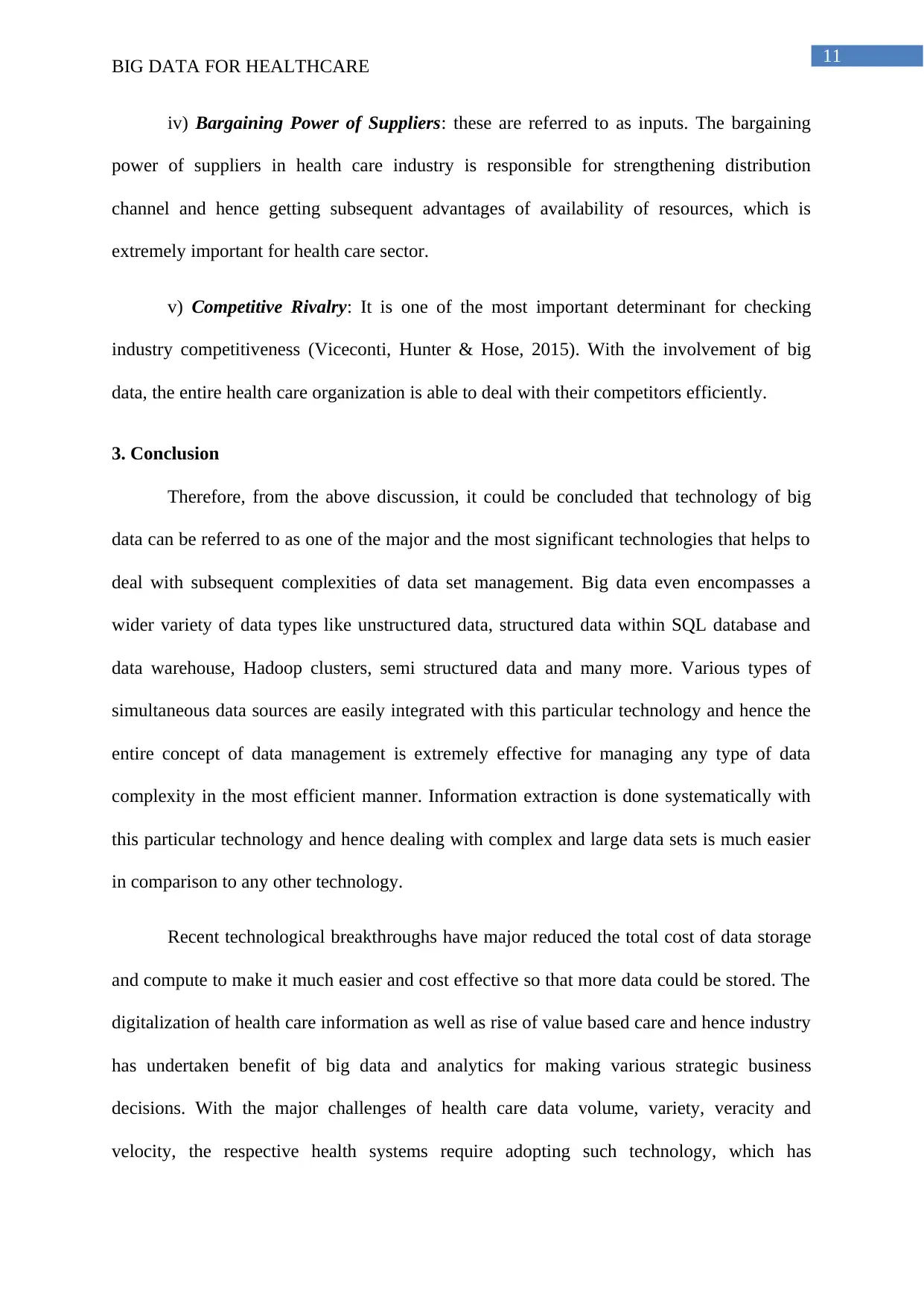
11
BIG DATA FOR HEALTHCARE
iv) Bargaining Power of Suppliers: these are referred to as inputs. The bargaining
power of suppliers in health care industry is responsible for strengthening distribution
channel and hence getting subsequent advantages of availability of resources, which is
extremely important for health care sector.
v) Competitive Rivalry: It is one of the most important determinant for checking
industry competitiveness (Viceconti, Hunter & Hose, 2015). With the involvement of big
data, the entire health care organization is able to deal with their competitors efficiently.
3. Conclusion
Therefore, from the above discussion, it could be concluded that technology of big
data can be referred to as one of the major and the most significant technologies that helps to
deal with subsequent complexities of data set management. Big data even encompasses a
wider variety of data types like unstructured data, structured data within SQL database and
data warehouse, Hadoop clusters, semi structured data and many more. Various types of
simultaneous data sources are easily integrated with this particular technology and hence the
entire concept of data management is extremely effective for managing any type of data
complexity in the most efficient manner. Information extraction is done systematically with
this particular technology and hence dealing with complex and large data sets is much easier
in comparison to any other technology.
Recent technological breakthroughs have major reduced the total cost of data storage
and compute to make it much easier and cost effective so that more data could be stored. The
digitalization of health care information as well as rise of value based care and hence industry
has undertaken benefit of big data and analytics for making various strategic business
decisions. With the major challenges of health care data volume, variety, veracity and
velocity, the respective health systems require adopting such technology, which has
BIG DATA FOR HEALTHCARE
iv) Bargaining Power of Suppliers: these are referred to as inputs. The bargaining
power of suppliers in health care industry is responsible for strengthening distribution
channel and hence getting subsequent advantages of availability of resources, which is
extremely important for health care sector.
v) Competitive Rivalry: It is one of the most important determinant for checking
industry competitiveness (Viceconti, Hunter & Hose, 2015). With the involvement of big
data, the entire health care organization is able to deal with their competitors efficiently.
3. Conclusion
Therefore, from the above discussion, it could be concluded that technology of big
data can be referred to as one of the major and the most significant technologies that helps to
deal with subsequent complexities of data set management. Big data even encompasses a
wider variety of data types like unstructured data, structured data within SQL database and
data warehouse, Hadoop clusters, semi structured data and many more. Various types of
simultaneous data sources are easily integrated with this particular technology and hence the
entire concept of data management is extremely effective for managing any type of data
complexity in the most efficient manner. Information extraction is done systematically with
this particular technology and hence dealing with complex and large data sets is much easier
in comparison to any other technology.
Recent technological breakthroughs have major reduced the total cost of data storage
and compute to make it much easier and cost effective so that more data could be stored. The
digitalization of health care information as well as rise of value based care and hence industry
has undertaken benefit of big data and analytics for making various strategic business
decisions. With the major challenges of health care data volume, variety, veracity and
velocity, the respective health systems require adopting such technology, which has
⊘ This is a preview!⊘
Do you want full access?
Subscribe today to unlock all pages.

Trusted by 1+ million students worldwide
1 out of 16
Related Documents
Your All-in-One AI-Powered Toolkit for Academic Success.
+13062052269
info@desklib.com
Available 24*7 on WhatsApp / Email
![[object Object]](/_next/static/media/star-bottom.7253800d.svg)
Unlock your academic potential
Copyright © 2020–2025 A2Z Services. All Rights Reserved. Developed and managed by ZUCOL.





